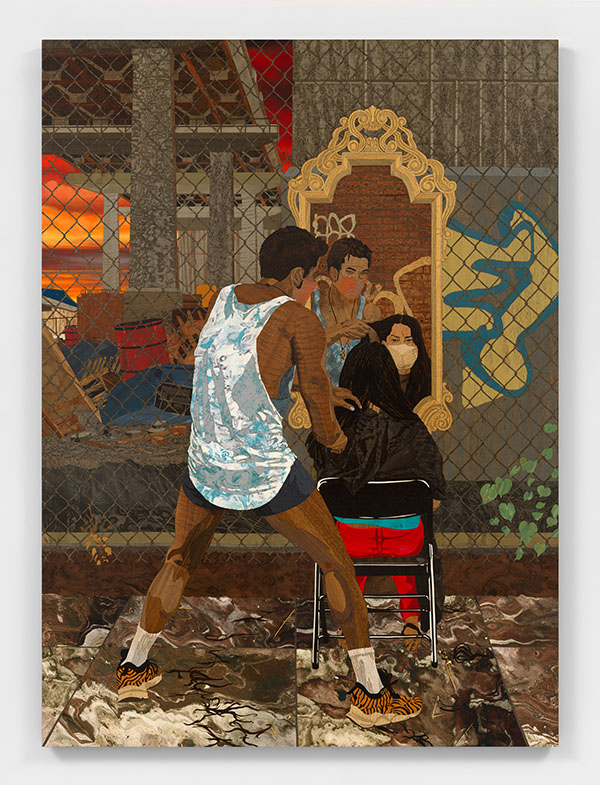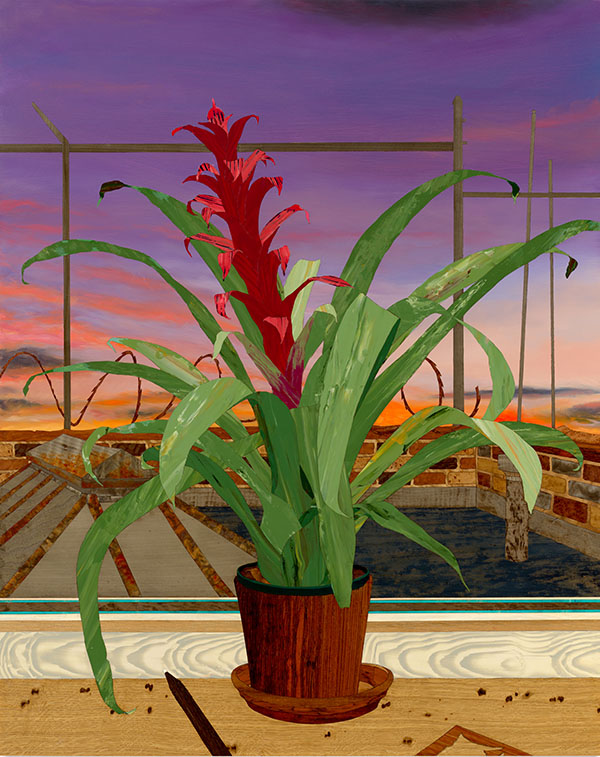Known for her works made of laser-cut marquetry, Alison Elizabeth Taylor captivates viewers with her skill and close consideration of minute details. Combining the medium more commonly seen in decorative arts with painted wood and photographic prints, Taylor has modernized the technique and created what she calls “hybrid marquetry.” Her aptly named exhibition Future Promise presented works made during the months when the city, along with the rest of the world, abruptly shut down and our understanding of normal life was redefined.
Taylor’s lockdown paintings tell familiar stories of interiority and allude to some of the new, confounding norms. In one work, two figures kiss from behind their facemasks. In another, someone has written “CDC” on a wall of graffiti along with the words “protect yourself and others.” Nearby, a painting of a blooming houseplant is ironically titled Here’s the Zoom Link (2021).
Taylor pairs these universal signs of the Covid era with experiences specific to New York, and reveals some of the deeper socioeconomic issues that came to light. Limited to our tiny spaces, the pandemic forced New Yorkers to creatively use the city as an extension of their homes. In Anthony Cuts under the Wburg Bridge, Sunset (2021), a hairdresser has taken his business to the street to style his patron’s hair en plein air. The viewer sees Anthony and his sitter from behind, their masked faces reflected in a golden mirror hung from a chain-link fence. Taylor enlivened the scene with meticulous details, from delicate hair clippings on the ground to the muscles in Anthony’s legs. The work is a testament to the perseverance of everyday people.

Alison Elizabeth Taylor, Anthony Cuts under the Wburg Bridge, Sunset, 2021. Courtesy James Cohan.
Opposite this empowering scene is Midwinter (2021), an image of four women luxuriating poolside, surrounded by palm trees and opulent draperies. The painting references wealthy snowbirds who annually flock to Florida to avoid northern winters. Considered normal in years prior, the departure from the city took on a different meaning during the pandemic. In part a reflection of the unequal way in which Covid impacted people—the divide between those who stayed and those who left—it is also seen as an indication of loyalty to New York.
Near this poolside scene was a monumental painting of a forest with sharp, gnarled branches projecting in all directions. Titled Meet You There (2021), the painting is unsettling, yet the title also suggests an invitation, as if the forest is a retreat; while threatening as an isolated, unknown space, nature is also something that protects us. Much like the pool painting, Meet You There, hints at another group who fled the city, those with second homes or family in the exurbs who spent their quarantine months protected in nature.
Poignant, skillful and laden with hidden meaning, the works in the show told a disparate story of the pandemic and held a revealing mirror to some of the deeply rooted inequities that defined our lives over the last year.


